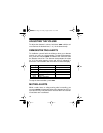
20
• At the end of a nickel-cadmium battery’s useful life, it must
be recycled or disposed of properly. Contact your local,
county, or state hazardous waste management authorities
for information on recycling or disposal programs in your
area. Some options that might be available are: municipal
curbside collection, drop-off boxes at retailers such as your
local RadioShack store, recycling collection centers, and
mail-back programs.
CHARGING RECHARGEABLE
BATTERIES
You can charge rechargeable batteries inside the safety light
using vehicle battery power (using the supplied DC power
cord) or standard AC power (using an optional AC adapter,
such as Cat. No. 273-1653). It takes about 10 hours to fully
charge the batteries. You can use the Safety Light while charg-
ing it, but this increases the charging time to about 20 hours.
Warning:
Do not connect a power cord to the Safety Light’s
D.C. 12V
jack if you installed non-rechargeable batteries (stan-
dard, extra-life, or alkaline). Non-rechargeable batteries
become hot and can even explode if you try to recharge them.
Using Vehicle Battery Power
Caution:
The supplied DC power cord supplies at least 12
volts and delivers at least 600 mA, and has a center positive
plug that properly fits the Safety Light’s
D.C. 12V
jack. Using a
power cord that does not meet these specifications could dam-
age the Safety Light or the power cord.
22-1698.fm Page 20 Friday, August 6, 1999 11:32 AM


















